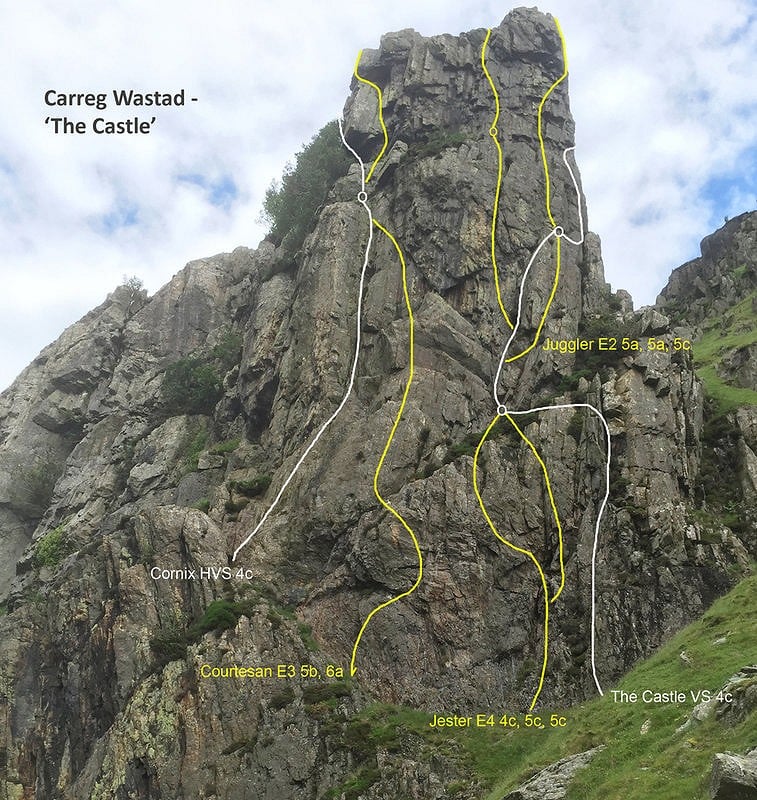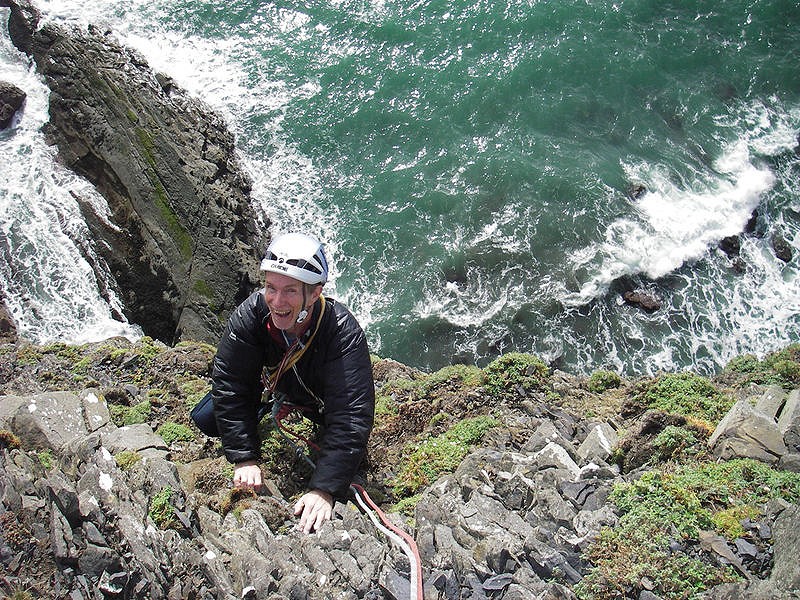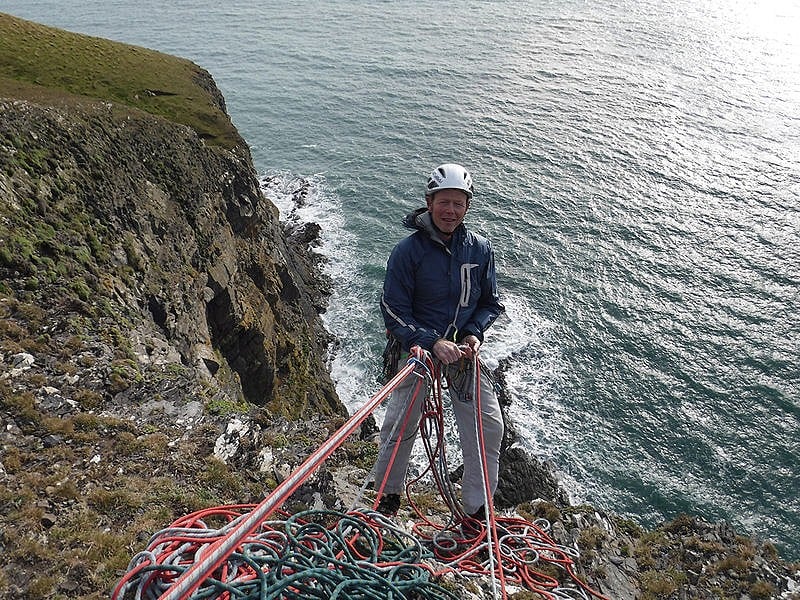
Sea cliff and adventure-climbing connoisseur Pat Littlejohn (OBE) regales us with some stories of new-routing in North Wales last summer...
Summer 2016 was a wet one in North Wales, with far fewer good climbing days than normal, especially on the mountain crags. For weekend visitors it must have been really tough. This is a piece about a few of the better new routes I did in North Wales last summer, many of which are at ‘accessible’ grades by modern standards and good adventures despite being far from the cutting edge.
Black Star (E4 5a, 5c) - Llyn Peninsula
The season kicked off with a visit by a good friend from the South West – Tony Penning. We have been climbing together on and off for over 30 years, always having great adventures and a lot of laughs. Tony wasn’t quite his usual self as he was recovering from a bout of pneumonia contracted over the winter, but his legendary enthusiasm was intact so as host I wanted to find a suitable new route to entertain him. I remembered a line I’d tried in 2011 (with Pete Judge), an impressive shale slab on a headland called Trwyn y Penrhyn, near Aberdaron. I had bailed out about 8m from the top due to bad rock and no protection, then while retrieving gear I gave the finish a clean but never got around to trying it again.
This would be an ideal line to get Tony back in the swing - serious but not too steep or technical. Tony’s humour always lightens any situation and when he sent me off with his catchphrase ‘leave all the worrying to me’, I felt ready to be more forceful this time and determined not to let him down. Once I got my head around climbing on shale again, the quality of the climbing was superb - very intricate, all about insecure moves between good resting footholds and always having to keep an eagle eye for protection. Climbing on shale will never be to everyone’s taste but this slab is an obvious challenge and gives a huge satisfying pitch, so we thought it would rate two stars on the Llyn Peninsula quality scale (which may not translate exactly to other areas). I was initially stuck for a name but months later decided to pay homage to David Bowie and call it Black Star.
Invisible Wall (E5 6a) – Dinas Cromlech
The next project was another line I’d failed on previously, this time in the Llanberis Pass. In my youth I’d always found the Pass a bit tame, but now I love the place - all that south-facing rock and an incredible variety of routes. Having done most of the classics I’m beginning to notice unclimbed lines, even on the popular Three Cliffs. Take Dinas Cromlech - midway between the first pitches of Ivy Sepulchre and Flying Buttress there is a steep compact wall which hundreds of good climbers must have walked beneath. It has a nice scoop line rising across it but the start of this is well guarded from all sides. Tim Jepson and I made an attempt in 2015, first trying a promising approach from the left which failed due to an absence of protection, then trying to move in from the far left and failing again. Finally we tried an obvious fault on the right which was a bit miss-aligned but looked like it would definitely go.
I soon realised that others had attempted this - there were cleaned holds and runner placements. I also found out why they hadn’t got very far - the rock became overhanging and flaky and the crack went blind. There was one more possible entry via a direct central line, but it looked very hard and by then we were too tired to give it a go. It wasn’t till June 2016 that I felt fit enough to warrant another look, slogging up to the crag on a fine but chilly evening. Luckily I’d warmed-up on the Cromlech Boulders because the climbing was immediately very steep and fingery. Craning up on small undercuts I found myself staring at a fortuitous microwire slot which gave confidence to launch up an overhanging groove to the start of the rising scoop. Here there was a resting shelf but I had an unusual problem – the cold north wind whipping up the Pass had numbed my left hand and I couldn’t get the feeling back, so there was nothing for it but to press on up the scoop with not much gear and one hand not quite sure what it was holding on to. The 35m pitch ends at some spikes from which you can abseil or scramble off on to Flying Buttress, but there are some walls above which might someday give continuation pitches.
‘The Castle’ routes – Carreg Wastad
Finding one decent new line in the Pass is a rare privilege, what’s the likelihood of a cluster of three on the most popular of the Three Cliffs, Carreg Wastad? I’ve always had a soft spot for this crag, not so much for the polished classics but for the area of cliff up to the right of the popular bit, which is high and complex and has strange multi-pitch routes like Bole Way, Main Scoop Route and Old Holborn. Early last year I did The Castle, a Very Severe taking the towering buttress at the far right of the cliff. Standing beneath the climb it was immediately obvious why it was given that name - the resemblance to a castle tower is uncanny. By chance my second failed to retrieve a runner, and abbing down to collect it I found myself descending past an impressive crack line, the sort of thing Brown or Whillans should have climbed in the 1950’s. There was no mention of it in the guidebook so before long Mr Jepson and I went up for a look.
I thought the crack would be Tim’s sort of thing, steep and hard but well-protected, so I took the first pitch to a nice stance directly below it. Tim got to the hard bit, placed lots of gear, started powering up the crack then for some reason changed his mind and began reversing. It was at that point a large undercut hold parted company with the cliff, along with Tim. I stopped Tim immediately but the rock was coming straight at me. Instinctively I pressed into the cliff, probably the wrong thing to do if you’re wearing a helmet. The rock caught me a glancing blow on the back of the neck, not too serious but enough to get the adrenalin going. “I think this pitch is more your sort of thing” was Tim’s verdict, so I took over the sharp end. My usual approach is to jam any crack but this one forced you into a strength-draining layback, bringing to mind Whillans and Grond. Fortunately there were good finishing jugs and I was soon belayed below a compact headwall. Despite trying several different ways we couldn’t top out that day, so Tim came back in the week to check out a few options from an ab rope.

Next visit he pointed me at the ‘best’ line, optimistic that it would go at a reasonable grade. I gave it my best shot, even hanging from a sling at one point, but had to give up. In the end we had to settle for a less ambitious pitch further left but at least our route now had a finish and shortly afterwards a name (with ‘castle’ connections) – Jester (E4 4c, 5c, 5c). The line of The Castle weaves around a bit and it was obvious that a more direct line would be possible. I embarked on it with Chris Radford, a fellow resident of Nant Gwynant. Chris took the second pitch and was placing gear when he fumbled and dropped an extender with nut attached. Impressively he caught it over the toe of his left foot, then after a moment’s thought flicked it up and caught it again. This dextrous manoeuvre inspired the route name – Juggler (another denizen of the castle) which although just a series of variations gave some nice technical climbing on the top pitch. It weighs in at E2 (5a, 5a, 5c).
The last of the trio proved the best. It started with the surprising discovery that an obvious hanging groove above the main pitch of Cornix (a classic HVS) hadn’t been climbed. By keeping well right of Cornix it was possible to find a long independent first pitch at 5b, above which a black groove sliced through the overhang. At first there were good bridging holds then the groove divided. Both ways looked hard but the right-hand seemed to end sooner so that’s what I tried, getting very close to good finishing holds but not quite able to reach them. So it was back down to a break below the overhang for a rest before throwing all remaining energy at the left-hand groove. Thin bridging brought a final bulge which looked mean and also a bit wet. I began to think I was heading for another failure till I thought about moving on to the left arête. Immediately good holds appeared the difficulties were over. Courtesan (E3 5b, 5c) completed the Castle trilogy.
Sense of Doubt (E5 5c, 6a, 5c, 5c) – Llyn Peninsula
And so to the big one; on the massive shale cliff known as Paitsh at Cilan Head. For anyone not acquainted with Cilan, it is possibly the most hard-core adventure climbing arena in England and Wales. Running along the west side of the headland is a mile-long succession of great cliffs and zawns, several of which are more than 250 feet high. Names like Chinatown, Paitsh, Black Bay and Cilan Main evoke excitement tinged with trepidation for anyone contemplating a climb there, especially if they know what they are letting themselves in for. Unlike the friendly weathered rock of Gogarth, the vast compact bands of shale and gritstone at Cilan form large sections of cliff which appear impossible to climb or to protect. Early pioneers at Cilan made sparing use of bolts to force lines like The Groove and Giant, but nowadays bolts are banished by general agreement and the order of the day is very adventurous trad climbing. I’ve been messing about on Paitsh for a number of years. The first breach of the cliff, towards the right hand side, was made by Dick Griffiths and Mick Pointon in 1994, a huge adventure route evocatively named Controlled Explosions (340ft E5 5c, 5c). I’ve had the pleasure of leading the top pitch twice now and have no plans to do so again.
Sharing its traumatic finish is my route Nighty Night (XS), another route not destined for popularity. Paitsh is split into two bays by a central spur which can be gained by a committing tidal traverse. This gave Steve Sustad and I the relatively friendly Hornblower (Mild XS) which having no climbing harder than 5a may one day be considered ‘classic’ should Cilan Head ever become fashionable (you never know!). Later Steve and I did No Country for Old Men (E3), a very committing high traverse of the cliff on bands of more solid rock. For some years the huge grey wall between Hornblower and Controlled Explosions was probably the largest expanse of unclimbed rock in North Wales.
Two years ago Tim Jepson and I made some inroads with a route called Darklands (E4), an on-sight epic spread over 3 days. Though a worthwhile route it avoided the main issue by a big diversion to the right. So the big wall still needed attention. I’d been telling the hard young trad-lads about it for some time but nobody took the bait and so (rather unfairly I thought) it was left to two OAP’s to give it a go. Paitsh finishes, where vertical shale blends gradually with a grass slope, are a climber’s worst nightmare. So far the number of leaders to have experienced them can be counted on one hand. Having already survived three I decided to make this one a bit safer by pre-cleaning the most lethal loose blocks, so one afternoon while my wife took a stroll around Cilan Head I abseiled down the top third of the wall to the main line of overhangs. This all seemed like climbable terrain - the question was, could it be reached from the Darklands entry some 60m down to the right? Another problem was that the way through the overhang was running with water. I had seen it bone dry in previous years, but winter 15/16 had been the wettest ever and the following summer not much better. I waited and waited for a dry spell, which never came, till eventually deciding to give it a try anyway.
Our day started with a big abseil on joined ropes to the base of Darklands. The ledge beneath it was wave-washed so we had to hang in slings a few feet up the corner. I was glad to get climbing and leave Tim dealing with the piles of rope, trying to keep them dry and belay me at the same time. At first the ground was familiar then I branched off left from Darklands into new territory. A line of holds tempted me leftwards but then ran into smoother rock. I looked back to my last runner which was more than thirty feet away, then retreated carefully. A higher line proved reasonable and led to some deep cracks where I was able to excavate a couple of perfect nut belays.

The next pitch began with a thin flake crack which terminated at an actual flake. I thumped it and tried prizing it off with my nut key but it stayed put, so I put a tape round it then moved up to stand on it. Above was a committing move to a possible good hold, but it would be irreversible and I couldn’t see beyond. I didn’t fancy falling and pulling the flake on top of me, so took the runner off and tried again. This felt worse, so back on it went. After half an hour of trying a lower line and getting nowhere, it was back again to the move, knowing it had to be done. Suddenly I was at the ‘good’ hold and there was no going back. A shallow crack took a cam then I was off along a line of rippled holds to reach a little oasis of slabbier rock with clusters of strange plants I couldn’t identify. Breaking out of this was bold and strenuous and I could feel myself beginning to tire from having to clean almost every hold and runner placement.
There was still bulging rock to negotiate before the belay at the overhang and my energy was flagging. In my youth I would have powered straight through it, but each time I tried my fingers began to uncurl and I had to down climb fast to avoid a fall. There had to be a technical solution - get the hold sequence exactly right and use the feet creatively to reduce the strain. At long last I did something that worked and hugged the belay ledge. Tim later told me I’d been on the pitch well over two hours. Tim followed, appearing to cruise everything until the last bulge, which he found tough. Above the stance was better-known terrain, but it was soaking wet and I knew I’d have to use aid to get through the overhang. A cam and a nut did the job, leaving something for others to free-climb in dry conditions.

Above this the rock became solid and gritty as I approached the traverse line of No Country. I had intended to belay here but daylight was starting to fade so I thought I should make for the top - a bad decision! I pressed on up an overhanging corner but rope drag was becoming a problem and the pieces of protection I needed had been placed far below. The minutes passed and doubts turned to certainties – I was going to have to retreat, less than ten metres from the top. For a moment I wondered if we had time to escape along the traverse of No Country, but if the gamble failed we’d be in much deeper trouble, with no option but to abseil on joined ropes into a rough sea. So I began lowering off.
After initial surprise at seeing me floating back into view, Tim took it all in his stride, lowering me another full rope length to low-tide ledges then rigging an abseil for himself. Had the tide been higher a major epic would have ensued, but as it was we just had to face the grind of a 70m prusik as the sun went down. A few days later we went back to finish the line, with hopes of free-climbing the overhang if it was dry. It wasn’t, but with a belay on the traverse of No Country the upper corner felt straightforward and even picking a way through the final tottering wall was OK compared to every other exit on the crag.
So Paitsh has another big route, messy and imperfect like the others but high on the scale of sea-cliff adventures. I like to think that if they fancied an easy but entertaining day, even the hard young trad-lads and laddesses might enjoy it.





















Comments